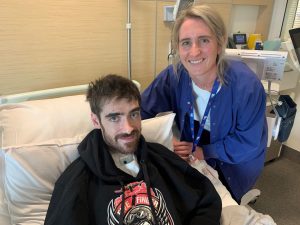To help patients in their recovery and to ensure they don’t stay in hospital longer than they need to, Central Adelaide has implemented a new model of care where some assessments can be performed at home.
Used in the UK and Australia’s eastern states, the Discharge to Assess (D2A) model sees patients who are medically ready to go home spend less time in an acute care setting.
CALHN Program Manager and physiotherapist Jaffar Liensavanh said this model of care was part of work to ensure patients are being cared for in the best place for their recovery.
How it works
As part of the initiative:
- there is early identification of patients who may benefit from being discharged home for assessment
- support services are organised to be in place ready for the return
- patients are assessed in their home environment
- support services are organised and activated enable patients to stay at home.
A D2A clinician discusses the option with the treating clinical team and patient to ensure the model is appropriate for the patient.
“We know people perform better in their own environment, and not in hospital. By discharging them back to their own homes, patients can successfully return to their routines and activities of daily living in familiar surroundings that they would otherwise not be able to demonstrate in the hospital setting,” he says.
“When a patient leaves hospital, a D2A clinician accompanies them together with our Integrated Care Outreach team, and the patient is assessed in their usual home environment.
If it’s assessed as safe, they can then continue their recovery and care at home.”
The experience so far
The initiative began at The Queen Elizabeth Hospital in February, and at the Royal Adelaide Hospital in late March.
To date, 47 patients have been taken on a D2A home visit from hospital, with 37 able to remain at home. Patients assessed as requiring further care and support have returned to other facilities, such as the Hampstead Rehabilitation Centre.
If there are patients that do need to return to hospital for acute care, the team then has a clear understanding of the issues and are able to have more informed care plans for the patient.
For Stephen, 66, he wanted to return home after he went to the RAH in an ambulance for a fractured humerus he sustained after a fall.
Once it was reset and placed in a sling, Stephen was assessed by the team, including a physiotherapist and was able to return home the day after his admission.
At home he’s been able to rest and has had tailored follow up care from the hospital team, as well as community services to assist with some tasks.
The next step will be to evaluate the project in partnership with the Commission of Excellence and Innovation in Health (CEIH), and to follow up with those patients who have been discharged to learn about their experience to help inform improvements to D2A.
Update on program – August 2022
Since it began, the Discharge to Assess program has taken 216 patients home through this service, with 199 of them able to remain at home.
Thanks to this program, these patients were able to leave hospital earlier and complete their recovery at home.



